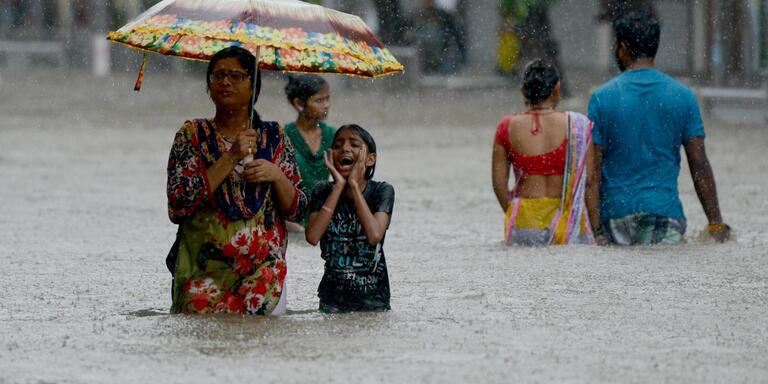
Drought, storms and floods displaced over 24 million people within their own countries in 2016 alone.
A new report from the Norwegian Refugee Council’s Internal Displacement Monitoring Centre (IDMC) features the first ever model forecasting internal displacement over the next decades. The forecast comes as the world copes with a record-breaking hurricane season and severe floods across Bangladesh, India and Nepal.
The report’s findings estimate that an average of almost 14 million* people are at risk of displacement caused by extreme weather every year. Population growth, combined with natural hazards, are the main elements related to this massive displacement.
But displacement numbers can be reduced drastically, the report argues.
Who is at risk?
Eight out of the ten countries with the highest risk of internal displacement by disasters and climate change are in southern and south-eastern Asia.
This year, floods killed over 1,200 people on the continent. Millions have fled their homes in India, Nepal and Bangladesh. As global temperatures rise, floods in these countries are likely to displace millions of people in the coming years.
India, regularly burdened with severe flooding, is especially at risk. According to the report, over 2.3 million people are already losing their homes to disasters every year – based on figures of displacement caused by destruction of houses during earthquakes, tsunamis, floods and tropical cyclones in recent years.
Why they are at risk?
People living in developing countries with high populations are particularly at risk.Poverty and inequality make people more vulnerable to climate change.
Many countries in Asia have numerous densely populated cities, where poor families live close to flood-prone river basins or in coastal areas exposed to cyclones. Small island states in the Caribbean are bearing the most damaging costs of harsh climate, because of their poor infrastructure and coping capacity coupled with a geographically exposed location.
Other large countries, like Russia and the US, could face huge displacement crises caused by an increase in cyclones and floods.
As impacts of climate change becomes more severe, the risk of displacement increase.
How can we prevent further displacement?
Poor construction in areas exposed to extreme weather often destroys homes during storms and floods.
In September 2017, for example, a staggering 40,000 people lost their homes to Hurricane Harvey in the southern US and across central America.
But there’s ways to mitigate the damages. Better urban planning can reduce the number of displaced people. Governments, too, can – and need to – strengthen the resilience of communities and livelihoods so that they are better able to withstand or adapt to the hazards they face.
Simple and low-cost technology like early warning systems can forecast heavy rains and winds. This can help prevent loss of life and damage to infrastructure.
The need to predict the risk and impacts of disaster displacement is an urgent, global priority.Alexandra Bilak, Director the Internal Displacement Monitoring Centre (IDMC)
Humanitarian response
Meanwhile, humanitarian organisations are working to inform people exposed to climate hazards on how they can survive through floods and drought.
NRC makes sure that clear, relevant information about climate hazards reaches vulnerable groups, local communities and decision-makers before it is too late. This work could entail, for instance, translating local weather forecasts into local languages and broadcast on the radio.
A step in the right direction
As long as people continue to live in areas with weak infrastructure exposed to hazards like tsunamis, floods and tropical cyclones, huge displacements are likely to continue through at least 2050.
“The need to predict the risk and impacts of disaster displacement is an urgent, global priority,” explains Alexandra Bilak, IDMC’s director.
She hopes that the report’s findings will spur efforts to improve quality of buildings in areas exposed to earthquakes, storms and floods.
*Figures exclude people fleeing from drought and rising sea levels.



